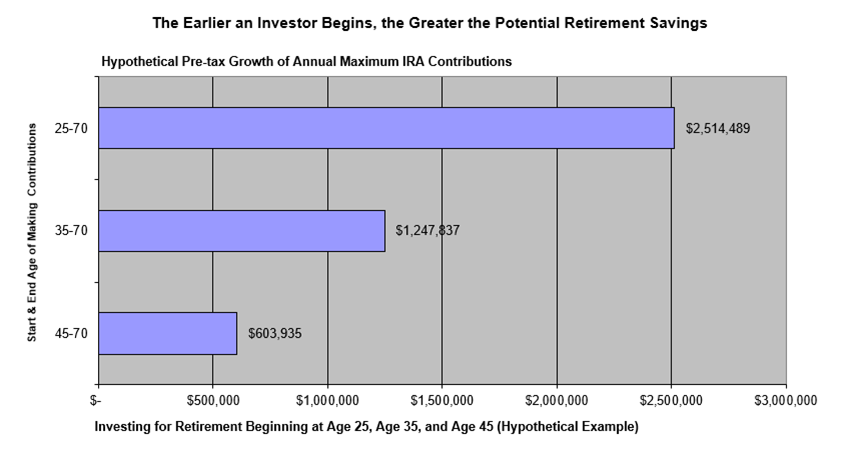Some retirement vehicles, such as Traditional IRAs and 401(k) plans, allow investments to grow federal income tax deferred. Others, such as Roth IRAs, allow them to grow federal tax free. In either case, there is no income tax on the money one invests or on the growth of that money while it's in the account. A distribution from a Roth IRA is tax free and penalty free provided the 5-year aging requirement has been satisfied and one of the following conditions is met: age 59½, death, disability, qualified first time home purchase.
You can reinvest any gains on your retirement plan assets, and get the potential benefits of compounding, for as long as that money is kept in the accounts.
The snowball effect of compounding can be quite powerful, since if you have gains on your initial principal, you may then start making gains on the gains and so on and so on. As an example, an initial principal of say $100 with a 10% annual return per year would be worth $110 after the first year, $121 the second year, $133.10 the third year, $146.41 the fourth year, and so on. This is, of course, a hypothetical situation and assumes a steady 10% return per year, which is not a likely scenario for any investor.
The snowball effect of compounding makes early investing, particularly in a retirement account due to the tax benefits, that much more enticing since the earlier you start investing, the more compounded returns you can hope to make. Additionally, the more you contribute to your retirement plan, the better; try to contribute the maximum amount each year so your principal may generate the most return possible.
For 401(k) plans, the employee contribution limit is $24,500 for 2026, with an additional $8,000 catch-up contribution allowed for employees age 50 or older. Those between ages 60 and 63 will be eligible to contribute up to $11,250 as a catch-up contribution. This means those 50 to 59 or 64 or older will be able to contribute up to $32,2500 in 2026 and those 60 to 63 will be able to contribute up to $35,750 in 2026. For IRA plans, the 2026 contribution maximum is $7,500. For those age 50 and over, the IRS allows an additional $1,100 catch up contribution. As long as you turn 50 during any day in the year, you are eligible for the catch-up contribution.
The benefits of compounding and tax-deferred growth potential are worth the efforts of early and continuous saving. To put all of this into context, let's say Julie starts contributing the maximum $7,500 IRA contribution at age 25 and keeps at it all the way through retirement at age 70. With annual compounding, she would have amassed $2,514,489 by 70. Compare this number to that of Julie’s friend Amy who didn’t start contributing the $7,500 max to her IRA until the age of 35. She only amassed $1,247, 837. For simplicity's sake, we are not calculating the catch-up allowance of an extra $1,100 once Julie or Amy hit 50. We are also assuming a hypothetical and steady 7% return per year, and we are not taking any taxes, fees, or inflation into account. As with before, this is not a likely scenario for any investor, but helps to demonstrate the point.



